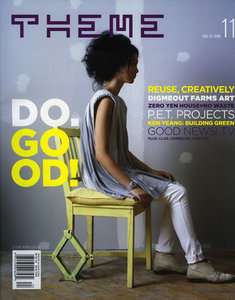Numeral (linguistics)
In linguistics, a numeral is a member of a word class (or sometimes even a part of speech) designating numbers, such as the English word 'two' and the compound 'seventy-seven'.
Identifying numerals
Numerals may be attributive, as in two dogs, or pronominal, as in I saw two (of them).
Many words of different parts of speech indicate number or quantity. Quantifiers do not enumerate, or designate a specific number, but give another, often less specific, indication of amount. Examples are words such as every, most, least, some, etc. There are also number words which enumerate but are not a distinct part of speech, such as 'dozen', which is a noun, 'first', which is an adjective, or 'twice', which is an adverb. Numerals enumerate, but in addition have distinct grammatical behavior: when a numeral modifies a noun, it may replace the article: the/some dogs played in the park → twelve dogs played in the park. (Note that *dozen dogs played in the park is not grammatical, so 'dozen' is not a numeral.)
Fatal Frame (film)
Fatal Frame is an upcoming Hollywood horror film. It was announced on a Niconico video stream on July 15, 2014. The film is set to begin as soon as the current new Fatal Frame project is completed, which consists of the fifth installment of the game, a novel, a Japanese film, and a manga.
References
Zero (name)
Zero or Zéro is surname, given name or pseudonym of the following people:
Zero is name of the following notable fictional characters:
Theme
Theme or themes may refer to:
Art
See also
Thematic vowel
In Indo-European studies, a thematic vowel or theme vowel is the vowel *e or *o from ablaut placed before the ending of a Proto-Indo-European (PIE) word. Nouns, adjectives, and verbs in the Indo-European languages with this vowel are thematic, and those without it are athematic. Used more generally, a thematic vowel is any vowel found at the end of the stem of a word.
Proto-Indo-European
PIE verbs and nominals (nouns and adjectives) consist of three parts:

The thematic vowel, if present, occurs at the end of the suffix (which may include other vowels or consonants) and before the ending:
Athematic forms, by contrast, have a suffix ending in a consonant, or no suffix at all (or arguably a null suffix):
For several reasons, athematic forms are thought to be older, and the thematic vowel was likely an innovation of late PIE: Athematic paradigms (inflection patterns) are more "irregular", exhibiting ablaut and mobile accent, while the thematic paradigms can be seen as a simplification or regularisation of verbal and nominal grammar. In the Anatolian languages, which were the earliest to split from PIE, thematic verbs are rare or absent. Furthermore, during late PIE and in the older daughter languages, a number of athematic forms were replaced by thematic ones, as in prehistoric Greek *thes- 'god' versus *thes-o- > Classical Greek θεός (theós).

Theme (magazine)
Theme is a quarterly lifestyle magazine that focuses on contemporary creative culture. In collaboration with a guest curator, the publishers collect stories based on a theme, which allows them to provide a coherent lens onto a topic. Initially covering contemporary Asian culture around the world, they opened their content to expanded topics in 2009. Started by the husband and wife team, Jiae Kim and John H. Lee, in Spring 2005, it was initially published four times a year. In 2008, Theme magazine started publishing bimonthly. In 2009 they returned to a quarterly schedule. The editor-in-chief of the magazine is John H. Lee who also publishes it with Jiae Kim.
In 2006 Theme won many design awards, including the Society of Publication Designers annual competition, and Print's Regional Design Competition. It has been featured in Adobe's advertising for its CS2 line of products.
Theme publishers operate a creative agency, called EMEHT. The agency provides creative services to clients like Dickies, Scion, Nike and fashion brands like Tess Giberson, Doo.Ri, Diane von Fürstenberg, Inhabit, and (capsule) tradeshow. EMEHT also created the logo and branding for Brooklyn Machine Works, a cult brand in the bicycling world.

Comet Arend–Roland
Comet Arend–Roland was discovered on November 8, 1956, by Belgian astronomers Sylvain Arend and Georges Roland on photographic plates. As the eighth comet found in 1956, it was named Arend–Roland 1956h after its discoverers. Because it was the third comet to pass through perihelion during 1957, it was then renamed 1957 III. Finally, it received the standard IAU designation C/1956 R1 (Arend–Roland), with the 'C/' indicating it was a non-periodic comet and the R1 showing it was the first comet reported as discovered in the half-month designated by R. The last is equivalent to the period September 1–15.
Observations
In November 1956, a double astrograph at the Uccle Observatory in Brussels was being used for routine investigation of minor planets. On November 8, 1956, the Belgian astronomers Sylvain Arend and Georges Roland discovered a comet on their photographic plates. At that time the comet was at visual magnitude 10, with a strong central condensation and a short tail. The early discovery of this comet allowed observing programs and equipment to be prepared well in advance.

Theme From
Empty words fired at me with an oral
cannon
WE WANNA BE HEARD!
Lousy jerks such bad breath I put the fan on
This is where we draw the line we're
sick of you wasting all our time
Talking about you you're given
something to revolve
WE WANNA BE SEEN!
You're given a clue a three piece
puzzle for you to solve
This is where we draw the line we're
sick of you wasting all our time
Game over you have played out your last card
WE WANNA DISAPEAR!
Constant looser a change for the better can't be that hard
This is where we draw the line we're

